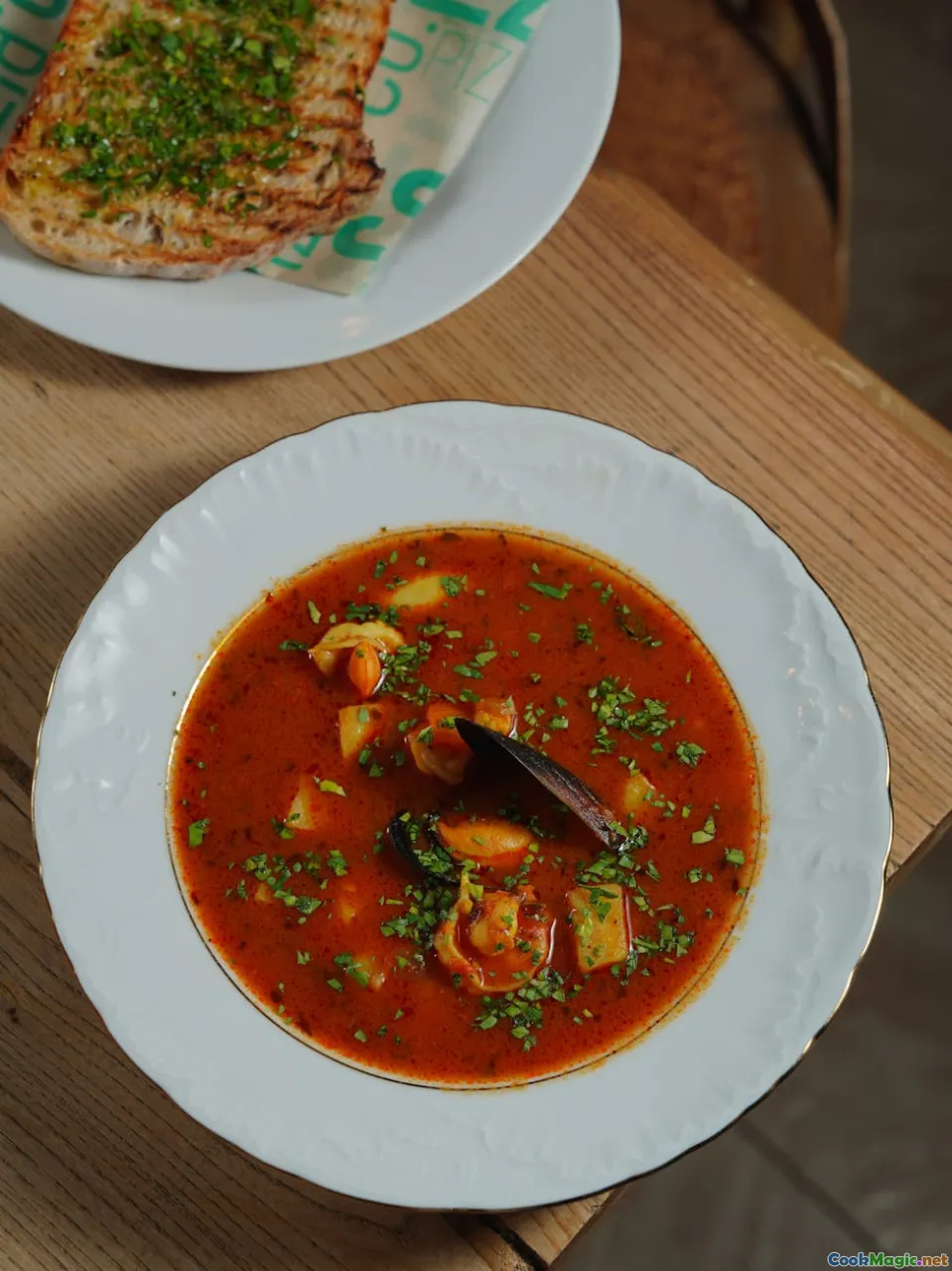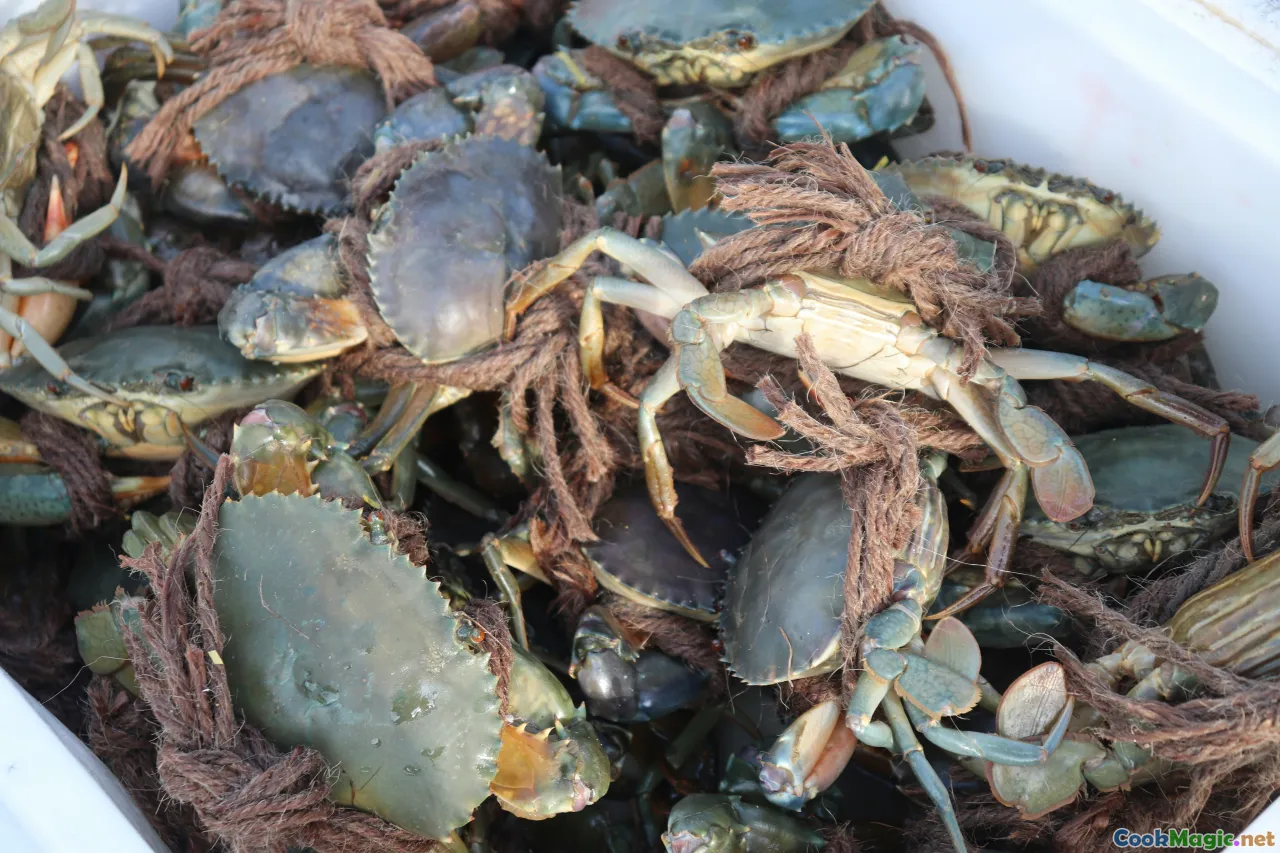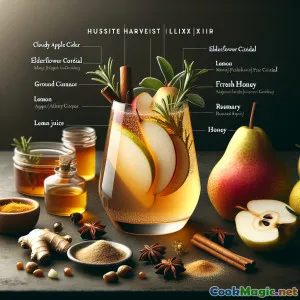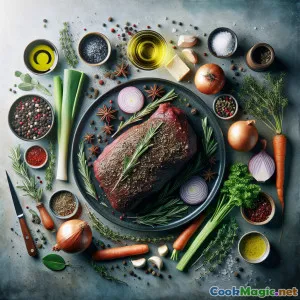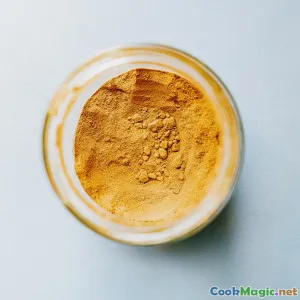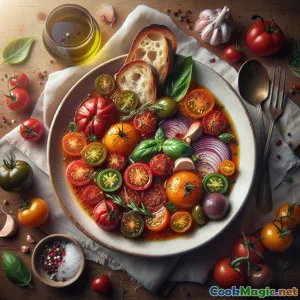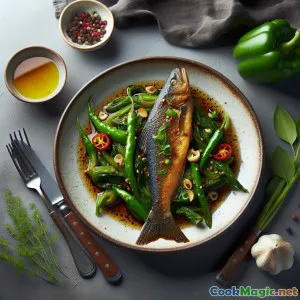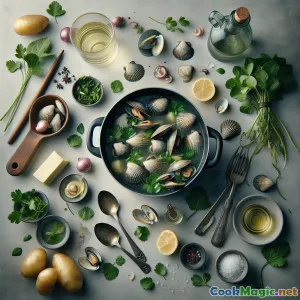
Zupa z Małżami i Artemizją: Brytyjski nadmorski akcent
(Mugwort Clam Soup: An English Coastal Twist)
(0 Recenzje)0
800
lipiec 18, 2025
Zgłoś problem
Składniki
-
500 grams Świeże małże
(Dokładnie oczyszczone; małże littleneck albo miejscowe brytyjskie małże.)
-
20 grams Świeże liście bylicy
(Tylko młode, delikatne liście. Opłucz i posiekaj.)
-
2 medium Szalotki
(Drobno posiekany)
-
100 ml wytrawne białe wino
(Najlepiej angielskie białe wino.)
-
20 grams Masło niesolone
(Dodaje bogactwo smaku. Można zastąpić olejem.)
-
500 ml Woda lub wywar rybny
(Preferowany jest wysokiej jakości wywar rybny.)
-
1 small (approx. 80g) Ziemniak
(Obrane, pokrojone w kostkę. O konsystencji woskowej, jak zaleciła Charlotte.)
-
1 small handful Świeża pietruszka
(Posiekany, do wykończenia.)
-
1 tsp Sól
(Spróbuj i dopraw ostrożnie.)
-
0.5 tsp Świeżo zmielony czarny pieprz
(Do smaku.)
-
0.5 tsp Skórka cytrynowa
(Świeżo starte; opcjonalne błyszczące wykończenie.)
(Dokładnie oczyszczone; małże littleneck albo miejscowe brytyjskie małże.)
(Tylko młode, delikatne liście. Opłucz i posiekaj.)
(Drobno posiekany)
(Najlepiej angielskie białe wino.)
(Dodaje bogactwo smaku. Można zastąpić olejem.)
(Preferowany jest wysokiej jakości wywar rybny.)
(Obrane, pokrojone w kostkę. O konsystencji woskowej, jak zaleciła Charlotte.)
(Posiekany, do wykończenia.)
(Spróbuj i dopraw ostrożnie.)
(Do smaku.)
(Świeżo starte; opcjonalne błyszczące wykończenie.)
Wartości odżywcze
- Porcje: 2
- Wielkość porcji: 1 miska (350ml)
- Calories: 320 kcal
- Carbohydrates: 25 g
- Protein: 21 g
- Fat: 10 g
- Fiber: 3 g
- Sugar: 2 g
- Sodium: 760 mg
- Cholesterol: 32 mg
- Calcium: 135 mg
- Iron: 11.2 mg
Instrukcje
-
1 - Szoruj i przygotuj małże:
Szoruj świeże małże pod bieżącą wodą. Odrzuć te, które są otwarte lub uszkodzone. Namocz je w osolonej wodzie przez 20 minut, odcedź i przepłucz, aby usunąć piasek.
-
2 - Zacznij smażyć aromatyczne składniki:
W garnku roztop masło na średnim ogniu. Dodaj pokrojone w kostkę szalotki i szczyptę soli. Delikatnie smaż 3–4 minuty, aż będą miękkie i przezroczyste, nie rumieniąc się.
-
3 - Dodaj ziemniaki i deglasuj:
Dodaj pokrojone w kostkę ziemniaki (jeśli używasz) i mieszaj przez 1 minutę. Wlej białe wino, zeskrob dno garnka i pozwól, aby alkohol odparował przez 2 minuty.
-
4 - Dodaj bulion i gotuj na małym ogniu:
Wlej wodę lub bulion rybny. Doprowadź do delikatnego wrzenia i gotuj 6–7 minut, aż ziemniak będzie ledwo miękki. Jeśli pomijasz ziemniaki, gotuj 4 minuty.
-
5 - małże i bylica pospolita:
Dodaj oczyszczone małże i większość posiekanej krwawnika pospolitego (zostaw odrobinę do dekoracji). Przykryj pokrywką i gotuj przez 3–5 minut, od czasu do czasu potrząsając garnkiem, aż wszystkie małże się otworzą. Usuń i wyrzuć wszystkie małże, które się nie otwierają.
-
6 - Wykończenie i Doprawianie:
Wymieszaj odłożony krwawnik pospolity, natkę pietruszki, czarny pieprz, sól do smaku i opcjonalną skórkę z cytryny. Spróbuj i dopraw według uznania.
-
7 - Serwować:
Łyżką wlej zupę i małże do misek. Udekoruj dodatkową pietruszką i delektuj się gorącą, parującą zupą, najlepiej z dobrym brytyjskim chlebem.
Szoruj świeże małże pod bieżącą wodą. Odrzuć te, które są otwarte lub uszkodzone. Namocz je w osolonej wodzie przez 20 minut, odcedź i przepłucz, aby usunąć piasek.
W garnku roztop masło na średnim ogniu. Dodaj pokrojone w kostkę szalotki i szczyptę soli. Delikatnie smaż 3–4 minuty, aż będą miękkie i przezroczyste, nie rumieniąc się.
Dodaj pokrojone w kostkę ziemniaki (jeśli używasz) i mieszaj przez 1 minutę. Wlej białe wino, zeskrob dno garnka i pozwól, aby alkohol odparował przez 2 minuty.
Wlej wodę lub bulion rybny. Doprowadź do delikatnego wrzenia i gotuj 6–7 minut, aż ziemniak będzie ledwo miękki. Jeśli pomijasz ziemniaki, gotuj 4 minuty.
Dodaj oczyszczone małże i większość posiekanej krwawnika pospolitego (zostaw odrobinę do dekoracji). Przykryj pokrywką i gotuj przez 3–5 minut, od czasu do czasu potrząsając garnkiem, aż wszystkie małże się otworzą. Usuń i wyrzuć wszystkie małże, które się nie otwierają.
Wymieszaj odłożony krwawnik pospolity, natkę pietruszki, czarny pieprz, sól do smaku i opcjonalną skórkę z cytryny. Spróbuj i dopraw według uznania.
Łyżką wlej zupę i małże do misek. Udekoruj dodatkową pietruszką i delektuj się gorącą, parującą zupą, najlepiej z dobrym brytyjskim chlebem.
Więcej o: Zupa z Małżami i Artemizją: Brytyjski nadmorski akcent
Mugwort Clam Soup: Ancient Greens, Coastal Bounty
Mugwort Clam Soup marries earthy woodland herbs with the bounty of the English coast for a wonderful, unusual dish that bridges tradition and modern English cookery.
History & Cultural Significance
Clam dishes have long featured in British coastal kitchens; native species like palourde or common cockle have provided rich nutrition for centuries. Adding mugwort introduces even deeper heritage: mugwort (Artemisia vulgaris), ubiquitous along hedgerows, fields, and riverbanks in the British Isles, served as both seasoning and medicinal herb for millennia. Historically, mugwort was prized for its digestive, tonic, and slightly bitter notes. Old English and Celtic gastronomy made liberal use of wild greens like mugwort, especially in spring for restorative dishes.
Though mugwort was traditionally added to stuffings and game or brewed in teas, its aromatic profile resonates with shellfish, subtly lending earth, bittersweet, and even anise-like undertones to seafood broths. Mugwort complements the salinity and delicacy of British clams surprisingly well, producing a soup at once ancient and modern.
Unique Aspects & Tips
- Selecting Mugwort: Use only the youngest mugwort leaves for the soup; older leaves may be fibrous. Mugwort is assertive so use sparingly until you appreciate its aromatic punch.
- Clams: Little English clams (like the palourdes of Cornwall or Scottish waters) are sweetest in late spring. Ensure they are spotless—traditional advice includes soaking in salty water to draw out sand.
- Broth: English dry white wine lifts the broth, while any coastal fish stock deepens seafood resonance. Chicken or vegetable stock works in a pinch but avoid overpowering the subtle herbs.
- Variations: Try with cockles or mussels if clams are unavailable. Add a dash of double cream for a nod to classic chowder or toss in wild leeks in early spring for even greater fragrance.
- Pairing: Serve with a hearty soda bread or a slice of nutty malted sourdough. To drink, a crisp English white wine or even non-alcoholic elderflower cordial complements herbal notes.
Final Thoughts
This Mugwort Clam Soup is a tribute to old English countryside foraging and the ever-present influence of the sea. The resultant bowl is fragrant, refreshing, briny, herbal, and slightly bitter—the kind of soup that surprises and satisfies palate and soul alike. Whether as a gentle supper to accompany the first sunny British days of spring or the anchor dish of a sophisticated dinner, this recipe connects you to centuries of herbcraft and seashore cookery. Mugwort is increasingly celebrated by modern British chefs; here, it shines as the signature green, with every bite evocative of brisk coastal walks and nostalgic stews.
Be bold in venturing beyond the familiar as English cuisine continues to revive ancient ingredients. The distinctive union of mugwort and clams proves that some remarkable combinations await in overlooked hedgerows and tidal beds—affirming the curiosity and adaptability at the heart of English food. Happy foraging, and enjoy your unique bowlful of Mugwort Clam Soup!

